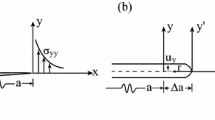Abstract
The interaction between an elastic triangular inclusion and a crack is investigated. The problem is formulated using the boundary integral equations for traction boundary value problems derived by Chau and Wang as basic equations. By using the continuity condition of traction and displacement on interface as supplement equations, a set of equations for solving the interaction problem between an inclusion and a crack are obtained, which are solved by using a new boundary element method. The results in terms of stress intensity factors (SIFs) are calculated for a variety of crack-inclusion arrangements and the elastic constants of the matrix and the inclusion. The results are valuable for studying new composite materials.
Similar content being viewed by others
References
Tamate O. The effect of a circular inclusion on the stresses around a line crack in a sheet under tension [J].International Journal of Fracture Mechanics, 1968,4(3):257–265.
Atkinson C. The interaction between a crack and an inclusion [J].International Journal of Engineering Science, 1972,10(2):127–136.
Erdogan F, Gupta G D, Ratwani M. Interaction between a circular inclusion and an arbitrarily oriented crack [J].Transactions of the ASME Journal of Applied Mechanics, 1974,41(4):1007–1013.
Lam K Y, Wen C. Enhancement/shielding effects of inclusion on arbitrarily oriented located cracks [J].Engineering Fracture Mechanics, 1993,46(3):443–454.
Cheeseman B A, Santare M H. The interaction of a curved crack with a circular elastic inclusion [J].International Journal of Fracture, 2000,103(3):259–277.
Helsing J. Stress intensity factors for a crack in front of an inclusion [J].Engineering Fracture Mechanics, 1999,64(2):245–253.
Atkinson C. Some ribbon-like inclusion problems [J].International Journal of Engineering Science, 1973,11(2):243–266.
Liu X H, Erdogan F. The crack-inclusion interaction problem [J].Engineering Fracture Mechanics, 1986,23(5):821–832.
Patton E M, Santare M H. The effect of rigid elliptical inclusion on a straight crack [J].International Journal of Fracture, 1990,46(1):71–79.
Hu K X, Chandra A. Interactions among cracks and rigid lines near a free surface [J].International Journal of Solids and Structures, 1993,30(14):1919–1937.
ZHANG Ming-huan, TANG Ren-ji. Interaction between crack and elastic inclusion [J].Applied Mathematics and Mechanics (English Edition), 1995,16(4):307–318.
TAO Fang-ming. TANG Ren-ji. The crack-inclusion interaction and the analysis of singularity for the horizontal contact [J]Applied Mathematics and Mechanics (English Edition), 2001,22(5): 547–556.
Anlas G, Santare M H. A model for matrix cracks in short fiber composites [J].International Journal of Solids and Structures, 1993,30(12):1701–1713.
Hwu C, Liang Y K, Yen W J. Interactions between inclusions and various types of cracks [J].International Journal Fracture, 1995,73(4):301–323.
WANG Ying-de, WANG Juan, FENG Chun-xiang,et al. Preparation and properties of non-circular SIC fibers with radar-absorbing function [A]. in: MAO Tian-xiang Ed.Present Situation and Development of Composite Materials [C]. Hefei: USTC Press, 2000, 57–61. (in Chinese).
WO Din-zhu,Encyclopedia of Composites [M]. Beijing: Chemical Industry Press, 2000, 1080–1130. (in Chinese)
Chau K T, Wang Y B. A new boundary integral formulation for plane elastic problems involving cracks and holes [J].International Journal of Solids and Structures, 1999,36(14):2041–2074.
Wang Y B, Chau K T. A new boundary element method for plane elastic problems involving cracks and holes [J].International Journal of Fracture, 1997,87(1):1–20.
Author information
Authors and Affiliations
Additional information
Contributed by WANG Yin-bang
Biography: JIAO Gui-de (1971−), Master
Rights and permissions
About this article
Cite this article
Gui-de, J., Yin-bang, W. The effect of an elastic triangular inclusion on a crack. Appl Math Mech 24, 427–433 (2003). https://doi.org/10.1007/BF02439622
Received:
Revised:
Issue Date:
DOI: https://doi.org/10.1007/BF02439622



